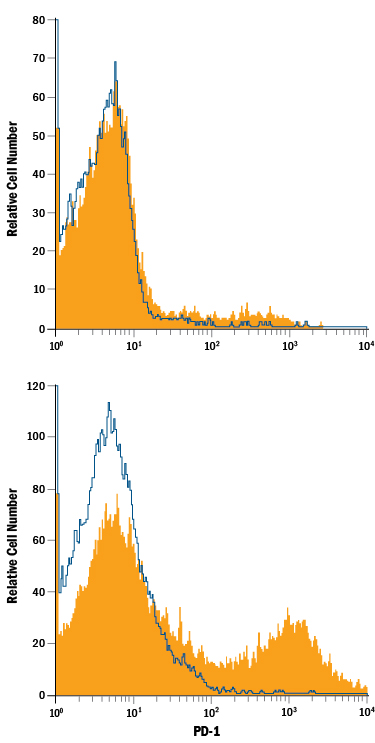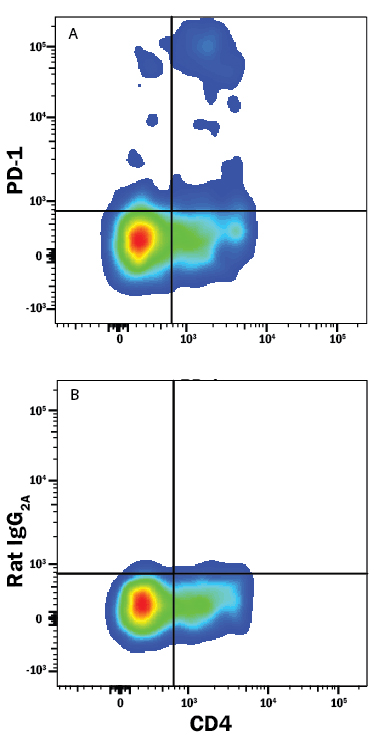Mouse PD-1 PE-conjugated Antibody Summary
Leu25-Gln167
Accession # Q02242
Applications
Please Note: Optimal dilutions should be determined by each laboratory for each application. General Protocols are available in the Technical Information section on our website.
Scientific Data
 View Larger
View Larger
Detection of PD‑1 in Mouse Splenocytes by Flow Cytometry. Mouse splenocytes treated with 5 µg/mL PHA for 72 hours were stained with Rat Anti-Mouse PD-1 PE-conjugated Monoclonal Antibody (Catalog # FAB7738P, filled histogram) or isotype control antibody (Catalog # IC006P, open histogram). View our protocol for Staining Membrane-associated Proteins.
 View Larger
View Larger
Detection of PD‑1 in Mouse Thymocytes by Flow Cytometry. Mouse thymocytes gated on CD3+CD8+cells were stained with Rat Anti-Mouse CD4 Alexa Fluor® 405-conjugated Monoclonal Antibody (Catalog # FAB554V) and either (A) Rat Anti-Mouse PD-1 PE-conjugated Monoclonal Antibody (Catalog # FAB7738P) or (B) Rat IgG2APhycoerythrin Isotype Control (Catalog # IC006P). View our protocol for Staining Membrane-associated Proteins.
Reconstitution Calculator
Preparation and Storage
- 12 months from date of receipt, 2 to 8 °C as supplied.
Background: PD-1
Programmed Death-1 (PD-1) is a type I transmembrane protein belonging to the CD28/CTLA-4 family of immunoreceptors that mediate signals for regulating immune responses (1). Other members of this family include CD28, CTLA-4, and ICOS (2-4). PD-1 is most closely related to CTLA-4 and shares approximately 24% amino acid (aa) sequence identity. The mouse PD-1 gene encodes a 288 aa protein with a putative 20 aa signal peptide, a 149 aa extracellular region with one immunoglobulin-like V-type domain, a 21 aa transmembrane domain, and a 98 aa cytoplasmic region. The cytoplasmic tail contains two tyrosine residues that form the immunoreceptor tyrosine-based inhibitory motif (ITIM) and immunoreceptor tyrosine-based switch motif (ITSM) that are important in mediating PD-1 signaling. Mouse and human PD-1 share approximately 69% aa sequence identity. Two B7 family proteins, PD-L1 (also called B7-H1) and PD-L2, have been identified as PD-1 ligands (5, 6). PD-1 is expressed on activated T cells, B cells, myeloid cells, and on a subset of thymocytes. PD-1 deficient mice have a defect in peripheral tolerance and spontaneously develop autoimmune diseases. Binding of PD-1 to PD-L1 or PD-L2 results in the inhibition of TCR-mediated proliferation and cytokine production as well as BCR-mediated signaling. PD-1 likely has an inhibitory role in regulating immune responses (1-4).
- Ishida, Y. et al. (1992) EMBO J. 11:3887.
- Sharpe, A.H. and G.J. Freeman (2002) Nat. Rev. Immunol. 2:116.
- Coyle, A. and J. Gutierrez-Ramos (2001) Nat. Immunol. 2:203.
- Nishimura, H. and T. Honjo (2001) Trends Immunol. 22:265.
- Latchman Y. et al. (2001) Nat. Immun. 2:261.
- Tamura, H. et al. (2001) Blood 97:1809.
Product Datasheets
Citation for Mouse PD-1 PE-conjugated Antibody
R&D Systems personnel manually curate a database that contains references using R&D Systems products. The data collected includes not only links to publications in PubMed, but also provides information about sample types, species, and experimental conditions.
1 Citation: Showing 1 - 1
-
PD-L2 Blockade Exacerbates Liver Lesion in Mice Infected with Capillaria hepatica through Reducing Alternatively Activated Macrophages
Authors: M Huang, X Li, X Zheng, F Wang, Y Zou, L Wang
Tropical medicine and infectious disease, 2023-01-06;8(1):.
Species: Mouse
Sample Types: Whole Cells
Applications: Flow Cytometry
FAQs
No product specific FAQs exist for this product, however you may
View all Antibody FAQsReviews for Mouse PD-1 PE-conjugated Antibody
There are currently no reviews for this product. Be the first to review Mouse PD-1 PE-conjugated Antibody and earn rewards!
Have you used Mouse PD-1 PE-conjugated Antibody?
Submit a review and receive an Amazon gift card.
$25/€18/£15/$25CAN/¥75 Yuan/¥2500 Yen for a review with an image
$10/€7/£6/$10 CAD/¥70 Yuan/¥1110 Yen for a review without an image

